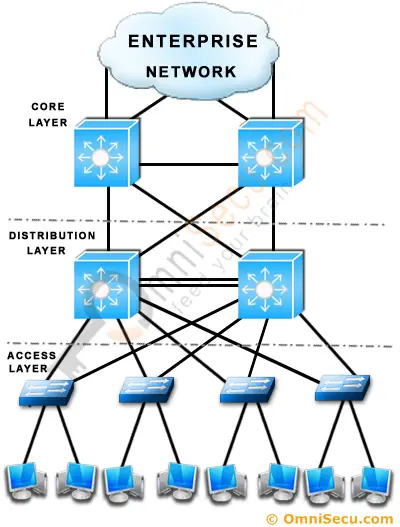hierarchical network model
this source from: http://www.omnisecu.com/cisco-certified-network-associate-ccna/three-tier-hierarchical-network-model.php
Cisco suggests a Three−Tier (Three Layer) hierarchical network model, that consists of three layers: the Core layer, the Distribution layer, and the Access layer. Cisco Three-Layer network model is the preferred approach to network design.

The above picture can further explained based on below picture.

Core Layer
Core Layer consists of biggest, fastest, and most expensive routers with the highest model numbers and Core Layer is considered as the back bone of networks. Core Layer routers are used to merge geographically separated networks. The Core Layer routers move information on the network as fast as possible. The switches operating at core layer switches packets as fast as possible.
Distribution layer:
The Distribution Layer is located between the access and core layers. The purpose of this layer is to provide boundary definition by implementing access lists and other filters. Therefore the Distribution Layer defines policy for the network. Distribution Layer include high-end layer 3 switches. Distribution Layer ensures that packets are properly routed between subnets and VLANs in your enterprise.
Access layer
Access layer includes acces switches which are connected to the end devices (Computers, Printers, Servers etc). Access layer switches ensures that packets are delivered to the end devices.
Benefits of Cisco Three-Layer hierarchical model
The main benefits of Cisco Three-Layer hierarchical model is that it helps to design, deploy and maintain a scalable, trustworthy, cost effective hierarchical internetwork.
Better Performance: Cisco Three Layer Network Model allows in creating high performance networks
Better management & troubleshooting: Cisco Three Layer Network Model allows better network management and isolate causes of network trouble.
Better Filter/Policy creation and application: Cisco Three Layer Network Model allows better filter/policy creation application.
Better Scalability: Cisco Three Layer Network Model allows us to efficiently accomodate future growth.
Better Redundancy: Cisco Three Layer Network Model provides better redundancy. Multiple links across multiple devices provides better redundancy. If one switch is down, we have another alternate path to reach the destination.
another source : http://www.ciscopress.com/articles/article.asp?p=2202410&seqNum=4
Hierarchical Network Design Overview (1.1)
The Cisco hierarchical (three-layer) internetworking model is an industry wide adopted model for designing a reliable, scalable, and cost-efficient internetwork. In this section, you will learn about the access, distribution, and core layers and their role in the hierarchical network model.
Enterprise Network Campus Design (1.1.1)
An understanding of network scale and knowledge of good structured engineering principles is recommended when discussing network campus design.
Network Requirements (1.1.1.1)
When discussing network design, it is useful to categorize networks based on the number of devices serviced:
- Small network: Provides services for up to 200 devices.
- Medium-size network: Provides services for 200 to 1,000 devices.
- Large network: Provides services for 1,000+ devices.
Network designs vary depending on the size and requirements of the organizations. For example, the networking infrastructure needs of a small organization with fewer devices will be less complex than the infrastructure of a large organization with a significant number of devices and connections.
There are many variables to consider when designing a network. For instance, consider the example in Figure 1-1. The sample high-level topology diagram is for a large enterprise network that consists of a main campus site connecting small, medium, and large sites.
 Figure 1-1 Large Enterprise Network Design
Figure 1-1 Large Enterprise Network Design
Network design is an expanding area and requires a great deal of knowledge and experience. The intent of this section is to introduce commonly accepted network design concepts.
NOTE
The Cisco Certified Design Associate (CCDA®) is an industry-recognized certification for network design engineers, technicians, and support engineers who demonstrate the skills required to design basic campus, data center, security, voice, and wireless networks.
Structured Engineering Principles (1.1.1.2)
Regardless of network size or requirements, a critical factor for the successful implementation of any network design is to follow good structured engineering principles. These principles include
- Hierarchy: A hierarchical network model is a useful high-level tool for designing a reliable network infrastructure. It breaks the complex problem of network design into smaller and more manageable areas.
- Modularity: By separating the various functions that exist on a network into modules, the network is easier to design. Cisco has identified several modules, including the enterprise campus, services block, data center, and Internet edge.
- Resiliency: The network must remain available for use under both normal and abnormal conditions. Normal conditions include normal or expected traffic flows and traffic patterns, as well as scheduled events such as maintenance windows. Abnormal conditions include hardware or software failures, extreme traffic loads, unusual traffic patterns, denial-of-service (DoS) events, whether intentional or unintentional, and other unplanned events.
- Flexibility: The ability to modify portions of the network, add new services, or increase capacity without going through a major forklift upgrade (i.e., replacing major hardware devices).
To meet these fundamental design goals, a network must be built on a hierarchical network architecture that allows for both flexibility and growth.
Hierarchical Network Design (1.1.2)
This topic discusses the three functional layers of the hierarchical network model: the access, distribution, and core layers.
Network Hierarchy (1.1.2.1)
Early networks were deployed in a flat topology as shown in Figure 1-2.
 Figure 1-2 Flat Switched Network
Figure 1-2 Flat Switched Network
Hubs and switches were added as more devices needed to be connected. A flat network design provided little opportunity to control broadcasts or to filter undesirable traffic. As more devices and applications were added to a flat network, response times degraded, making the network unusable.
A better network design approach was needed. For this reason, organizations now use a hierarchical network design as shown in Figure 1-3.
 Figure 1-3 Hierarchical Network
Figure 1-3 Hierarchical Network
A hierarchical network design involves dividing the network into discrete layers. Each layer, or tier, in the hierarchy provides specific functions that define its role within the overall network. This helps the network designer and architect to optimize and select the right network hardware, software, and features to perform specific roles for that network layer. Hierarchical models apply to both LAN and WAN design.
The benefit of dividing a flat network into smaller, more manageable blocks is that local traffic remains local. Only traffic that is destined for other networks is moved to a higher layer. For example, in Figure 1-3 the flat network has now been divided into three separate broadcast domains.
A typical enterprise hierarchical LAN campus network design includes the following three layers:
- Access layer: Provides workgroup/user access to the network
- Distribution layer: Provides policy-based connectivity and controls the boundary between the access and core layers
- Core layer: Provides fast transport between distribution switches within the enterprise campus
Another sample three-layer hierarchical network design is displayed in Figure 1-4. Notice that each building is using the same hierarchical network model that includes the access, distribution, and core layers.
 Figure 1-4 Multi Building Enterprise Network Design
Figure 1-4 Multi Building Enterprise Network Design
NOTE
There are no absolute rules for the way a campus network is physically built. While it is true that many campus networks are constructed using three physical tiers of switches, this is not a strict requirement. In a smaller campus, the network might have two tiers of switches in which the core and distribution elements are combined in one physical switch. This is referred to as a collapsed core design.
The Access Layer (1.1.2.2)
In a LAN environment, the access layer highlighted grants end devices access to the network. In the WAN environment, it may provide teleworkers or remote sites access to the corporate network across WAN connections.
As shown in Figure 1-5, the access layer for a small business network generally incorporates Layer 2 switches and access points providing connectivity between workstations and servers.
 Figure 1-5 Access Layer
Figure 1-5 Access Layer
The access layer serves a number of functions, including
- Layer 2 switching
- High availability
- Port security
- QoS classification and marking and trust boundaries
- Address Resolution Protocol (ARP) inspection
- Virtual access control lists (VACLs)
- Spanning tree
- Power over Ethernet (PoE) and auxiliary VLANs for VoIP
The Distribution Layer (1.1.2.3)
The distribution layer aggregates the data received from the access layer switches before it is transmitted to the core layer for routing to its final destination. In Figure 1-6, the distribution layer is the boundary between the Layer 2 domains and the Layer 3 routed network.
 Figure 1-6 Distribution Layer
Figure 1-6 Distribution Layer
The distribution layer device is the focal point in the wiring closets. Either a router or a multilayer switch is used to segment workgroups and isolate network problems in a campus environment.
A distribution layer switch may provide upstream services for many access layer switches.
The distribution layer can provide
- Aggregation of LAN or WAN links.
- Policy-based security in the form of access control lists (ACLs) and filtering.
- Routing services between LANs and VLANs and between routing domains (e.g., EIGRP to OSPF).
- Redundancy and load balancing.
- A boundary for route aggregation and summarization configured on interfaces toward the core layer.
- Broadcast domain control, because routers or multilayer switches do not forward broadcasts. The device acts as the demarcation point between broadcast domains.
The Core Layer (1.1.2.4)
The core layer is also referred to as the network backbone. The core layer consists of high-speed network devices such as the Cisco Catalyst 6500 or 6800. These are designed to switch packets as fast as possible and interconnect multiple campus components, such as distribution modules, service modules, the data center, and the WAN edge.
As shown in Figure 1-7, the core layer is critical for interconnectivity between distribution layer devices (for example, interconnecting the distribution block to the WAN and Internet edge).
 Figure 1-7 Core Layer
Figure 1-7 Core Layer
The core should be highly available and redundant. The core aggregates the traffic from all the distribution layer devices, so it must be capable of forwarding large amounts of data quickly.
Considerations at the core layer include
- Providing high-speed switching (i.e., fast transport)
- Providing reliability and fault tolerance
- Scaling by using faster, and not more, equipment
- Avoiding CPU-intensive packet manipulation caused by security, inspection, quality of service (QoS) classification, or other processes
Two-Tier Collapsed Core Design (1.1.2.5)
The three-tier hierarchical design maximizes performance, network availability, and the ability to scale the network design.
However, many small enterprise networks do not grow significantly larger over time. Therefore, a two-tier hierarchical design where the core and distribution layers are collapsed into one layer is often more practical. A “collapsed core” is when the distribution layer and core layer functions are implemented by a single device. The primary motivation for the collapsed core design is reducing network cost, while maintaining most of the benefits of the three-tier hierarchical model.
The example in Figure 1-8 has collapsed the distribution layer and core layer functionality into multilayer switch devices.
 Figure 1-8 Two-Tier Hierarchical Design
Figure 1-8 Two-Tier Hierarchical Design
The hierarchical network model provides a modular framework that allows flexibility in network design and facilitates ease of implementation and troubleshooting.
Activity 1.1.2.6: Identify Hierarchical Network Characteristics

